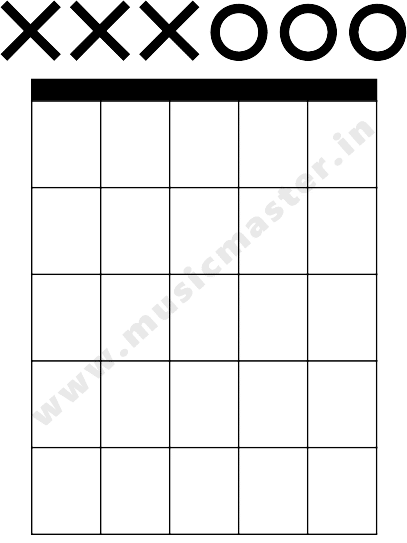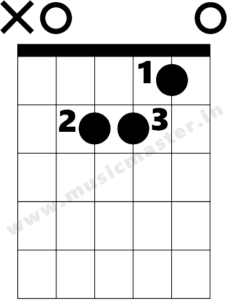The E minor scale on guitar is an interesting and fundamental scale to learn. It is a bit sadder and/or more aggressive sounding in comparison to the other major scale. The E minor key is the relative minor of the G major. So, just like the relative G major key, the E minor key also has one sharp (#) in its key signature next to the treble clef (𝄞). Also one can create different other related chords in E minor. In this blog you will learn all about different E minor scale guitar notes and different E minor scale guitar position and how to play each notes in your guitar.
Songs In The Key of E minor
There are a variety of songs created in the key of E minor scale guitar notes. Most heavy-hitting songs are in the E minor are not only fun but also quite easy to jam to.
Here are some of the most famous hard-rock songs in the key of E minor: Nothing Else Matters (Metallica), Blood Brothers (Iron Maiden), Last Resort (Papa Roach), Back In Black (AC/DC), Rock You Like A Hurricane (Scorpions), Paranoid (Black Sabbath), Balls To The Wall (Accept) and Whole Lotta Love (Led Zeppelin).
So, most or all of the notes in the kind of songs mentioned above are derived from the E minor scale. So, what are they? Let’s find out.
What Are The E minor Scale Guitar Notes?
To have a better understanding of what notes are within the scale of E minor, you need to play them all on the open E string (the 1st string), which when played open is the root note of the scale. Given below is a E-minor scale guitar fret-board diagram that shows all the notes in the E minor if played from the open E guitar string all the way to the 12th fret.

These E minor scale guitar notes are created based on the minor scale formula, which is different from the major scale formula. The minor scale formula using the concept of intervals is: tone, semi-tone, tone, tone, semi-tone, tone, tone or TSTTSTT for short.
How To Play E minor Scale Notes on Guitar?
The first note is the 1st string open (E). The next note according to the formula is two frets away i.e., on the 2nd fret (F#). The next note is just a semi-tone away. So, play the immediate next fret or the 3rd fret (G). The following two E minor scale guitar notes are both a tone away. So, they are at the 5th and 7th frets which are A and B respectively.
The next note is also just a semi-tone higher. So play the 8th fret which happens to be the C note. After that play the 10th fret since the next note according to the formula is a tone higher. Finally, the last note is similarly a tone higher. Hence play the 12th fret which is the higher-sounding root note E. Check the above image for better understanding.
E minor Scale Guitar Tab
Given below are the tablature for E minor scale on guitar For now, you may use any finger of your fretting hand to play the notes of the E minor scale.

Unlike the major scale formula where the 3rd and 4th notes and the 7th and 8th notes have semi-tone intervals, here the 2nd and 3rd notes and 5th and 6th notes are the ones with the semi-tone intervals. You may remember this the next time you try to re-create the notes of a minor scale.
Of course, the scale position above is just to figure out the E minor scale guitar notes. This is not often used since it is impractical to constantly shift the fretting hand position just to play one octave of this scale. As such, there are various E minor scale positions spanning across a few frets involving more than one string. Check them out below:
Different E minor scale Positions
1. Open Position

This is first of all the E minor scale guitar positions since all the notes are conveniently within the first four frets of the guitar. Also, some notes are played open. Keep your fretting hand close to the first four frets to play the notes of the E minor scale in the open position. You may have to move your fretting hand up by a fret to use the pointer and ring finger to play E & F# on the 4th string at the 2nd and 4th frets in lieu of the middle and little fingers. Just remember to move your hand back to the original place to continue playing the rest of the notes.
Here are the tablatures for the open position of the E minor scale. Follow the italic numbers on top of the score which denotes the following fingers of the fretting hand (that holds down the strings on the fretboard).
1 – pointer/index finger 2 – middle finger
3 – ring finger 4 – little finger

2. Second Position

As the name suggests, this E minor scale guitar position starts at the 2nd fret. Move your fretting hand up by a fret so that the pointer, middle, ring and little fingers can press down the 2nd, 3rd, 4th and 5th frets respectively. All four fingers of the fretting hand are used to play the notes in the second position of the E minor scale. Check out the tablatures below with finger numbers provided on top of the score.

3. Fourth Position

In this scale position, we will be playing the notes of the E minor scale across five frets. Reposition your fretting hand up to the 5th fret to play the notes on the 6th and 5th strings. Next, move your entire hand down to the 4th fret use the index, middle and ring fingers to hold down the notes on the 4th and 3rd strings. Finally, bring the fretting hand back to the original place to play the 3 notes on the 2nd and 1st strings as mentioned in the tablatures provided below.

4. Seventh Position

All notes in this scale shape are confined within the 7th and 11th frets of the guitar. The seventh scale position involves the notes of the E minor scale that are in the same octave as the one in the 4th position scale shape. Some of these notes here were already played in the previous scale shape as well. Move your fretting hand near the 7th fret of the guitar to play this scale shape. Tablatures below have finger numbers in italics and will guide you through this scale shape.

5. Eighth Position

As you may have figured it out, this E minor scale guitar position start on the 8th fret. The first three notes at 8th, 10th and 12th frets on the 6th string may involve the fretting hand to stretch quite a lot. After playing these notes, you can place your hand near the 9th fret to play each of the 3 notes on the 5th, 4th and 3rd strings. Finally, move your fretting hand up by a fret to access the last five notes on the 2nd and 1st strings. Refer to the tablatures below with italicized finger numbers.

6. Eleventh Position

The last practically playable scale position (especially on the acoustic guitar) starts at the 12th fret of the 6th string. So, move your fretting hand there. But, since the notes on the 3rd string start at the 11th fret, this scale position is considered to be the eleventh one. So, just for the notes on that string, move your hand down by a fret. Naturally, for the notes on the 2nd and 1st strings, move the hand back to the initial spot.

Once you’ve practiced any one of the E minor scale guitar positions discussed above, try the very same scale shape in reverse order. Start from the last note on the first string and play the remaining notes one by one until you get to the first note on the 6th string, which will now become the last note of the scale. Try this out with the other scale positions as well.
Now let’s see how the notes in the E minor scale is capable of creating the infamous E minor chord that we all love to play.
The E Minor Triad

Like most major and minor chords, the E minor scale guitar chord is also created with the notes of the E minor triad. If you recall, a triad is a three-note chord comprising of the 1st, 3rd and 5th notes of its respective scale.
So, going by that theory, the E minor triad can be made up of the notes E, G and B since these are the 1st, 3rd and 5th notes of the E minor scale. You can play the first three strings as it is without the fretting hand touching them. These open notes by themselves are G, B and E, which are the notes we discussed as being in the E minor triad.

Playing the full E minor scale guitar is not that difficult either. You need to press the middle and ring fingers at the 2nd fret on the 5th and 4th strings, leaving all other strings open. When you play this chord, you can hear the root notes on the open 6th and 1st strings and also on the 4th string which is held down at the second fret with your ring finger.

The E minor chord, just like any other chord, sounds better when played with a combination of other chords that are related to it’s key. So, here are the other related chords of the E minor key.
Related Chords in E minor
1. F# diminished

Any diminished chord triad can be created by flattening the 3rd and 5th notes of their respective major scale. The F # diminished triad consists of the notes F#, A and C. To play the F# diminished chord, start by barring the 6th and 4th strings at the 2nd fret using your pointer. Bring your middle finger to hold the 5th string at the 3rd fret. Finally, add your ring finger at the 4th fret of the 4th string to play the higher octave of the root note (F#).
2. G major

The G major chord is one of the fundamental open chords on the guitar. This chord is quite frequently played with other open position chords like E minor, C major and D major. The G major is the relative major of E minor. The G major triad consists of the notes G, B and D. The pointer and middle fingers hold the 5th and 6th string at the 2nd and 3rd frets, while the ring finger folds down the 1st string at the 3rd fret. The other strings in the middle are left open.
3. A minor

This may be a chord you’re already familiar with. The A minor triad is created with the notes A, C and E. It is the relative minor of C major. This open chord is played across five strings starting with the root note on the 5th string open (A). The middle and ring fingers hold down the 4th and 3rd strings at the 2nd fret while the index finger holds the 2nd string at the 1st fret. The 1st string is also left open.
4. B minor

This chord shape of the B minor chord is derived from transposing all the notes in the open position of the A minor chord by a tone interval. The B minor chord is the relative minor of D major. It is made up of the notes in its triad B, D and F#. Barre the 2nd fret with your pointer. Next, hold the 4th and 3rd strings with your ring and little fingers at the 4th fret. Finally add the middle finger on the 2nd string at the 3rd fret. These three fingers hold a chord shape similar to the A minor chord in the open position.
5. C major

The very first open chord for most guitar players, the C major chord is the relative major of A minor. It consists of the notes A, C and E. Some of the notes may be repeated when held across different E minor scale guitar positions across all the strings, but they would be higher in pitch. For the open position, hold down the 5th and 4th strings with your ring and middle fingers at the 3rd and 4th frets. Next, hold the 2nd string at the 1st fret. Leave the 3rd and 1st strings open. With the picking hand, strum from the 5th string all the way to the first one.
6. D major

Another open chord that is played far too many times with other open chords The D major triad is formed from the 1st, 3rd and 5th notes of the D major scale. These notes are D, F# and A. The D major is the relative major of B minor. The open D major chord is played across 4 strings starting from the root note (D) which is the 4th string open. The 3rd and 1st strings are held down at the 2nd fret using the pointer and middle fingers while the ring finger presses the 2nd string at the 3rd fret.
You can try playing some or all of these chords in any combination of your choice. But, it may sound better if you start from the E minor chord and then play the other relative chords and finally end it with the chord you initially started with. Most of these chords are often used in the songs mentioned earlier.
Switching between these chords needs to be quick and seamless. So, practice them constantly with different strumming patterns and with the metronome. Set the metronome at a really slow tempo like 50 or 60 BPM. Once you’re able to switch between chords in time, keep increasing the tempo by 10 BPM until you can comfortably switch between these chords even at much higher speeds like 120-150 BPMs. Most rock songs have tempos ranging from 110 BPM to 140 BPM. So practice, practice, practice!
































